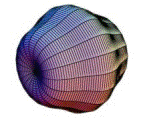Department of Physics and Astronomy: Publications and Other Research

Timothy J. Gay Publications
Document Type
Article
Date of this Version
2020
Citation
American Journal of Physics (September 2020) 88(9): 704-710
doi: 10.1119/10.0001388
Abstract
An American football is a rotationally symmetric object, which, when well-thrown, spins rapidly around its symmetry axis. In the absence of aerodynamic effects, the football would be a torque-free gyroscope and the symmetry/spin axis would remain pointing in a fixed direction in space as the football moved on its parabolic path. When a pass is well-thrown through the atmosphere, however, the symmetry axis remains—at least approximately—tangent to the path of motion. The rotation of the symmetry axis must be due to aerodynamic torque; yet, that torque, at first glance, would seem to have precisely the opposite effect. Here, we explain the action of aerodynamics on the ball’s orientation at second glance.
Included in
Atomic, Molecular and Optical Physics Commons, Other Physics Commons, Sports Studies Commons


Comments
Copyright 2020, American Association of Physics Teachers. Used by permission